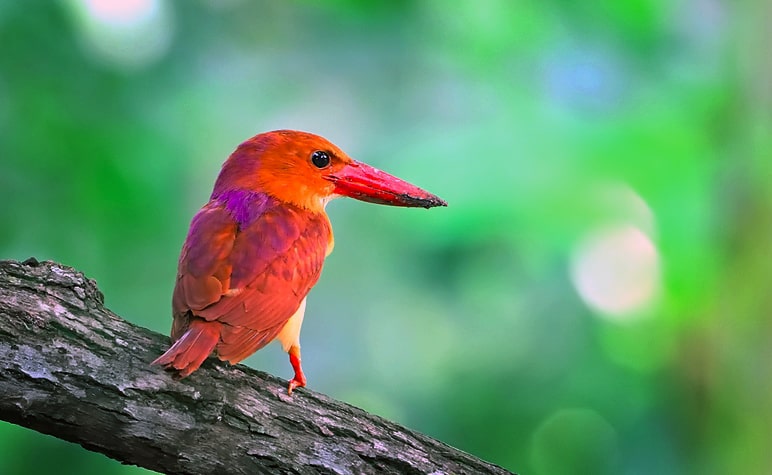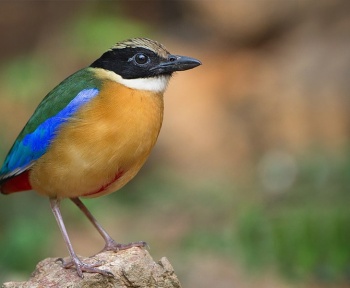Sundarban is considered to be one of the most important biodiversity hotspots in India. It is popularly known for the lush green mangroves and Coastal forests. It provides shelter to a wide variety of species. It is abundant in the Royal Bengal Tiger, rare species of Dolphins, and Crocodile. Coming to birds, the ecological diversity of the region in terms of birds is inexplicably wide.
Why is Sundarban important in terms of the Conservation of Wildlife?
The importance of Sundarban in the conservation of several wildlife species intensifies due to the presence of nearly 356 species of birds, 11 species of rare turtles, 37 varieties of snakes, 350 species of fishes, and 753 species of insects, including several rare species. It is unequivocally accepted that Sundarban apart from its scenic beauty it holds a vital position to consolidate the conservation of several wildlife species.
According to the latest reports, Sundarban is home to 428 species of birds including some like Masked Finfoot and Buffy Fish Owl which are exclusively found in Sundarbans. Reportedly it offers a wide variety of Kingfisher species and other rare species like Goliath heron and Spoon-billed Sandpiper. Every one out of three bird species in India is found in Sundarbans establishing the severe importance of its conservation. For birdwatchers and wildlife photographers Sundarbans is equivalent to a pilgrimage.
Specific features of the Ruddy King Fisher
Colour Specificity
The Ruddy Kingfishers possess a red body of rustic hue. It is intricately featured with a red beak and the rumps are subtly designed with vibrant cyan-blue blazes. It has distinctly giant, red bill and similar hued legs. The chromatic transition extends to a fan-shaped tail, which is purple-colored. A vibrant white patch can be found on the throat and sometimes on the breast. Be it the rustic red body or the detailed wings, or the purple-hued hinder region, nature has crafted a unique and extraordinarily beautiful creation of its out of its creativity. It has got a plain head pattern and dark brown eyes with rufous colored forehead and brownish-orange crown, scientific name is Halcyon Coromanda.
Behavioral Specificity
These 25-27cm sized and 60-94g weighing birds are shy in nature. The shy nature of this bird is well understandable because of its unique behavior. It prefers tall trees of the forest and interiors of jungles which are thickly enrobed with dense big trees. It is most active during the early hours of the morning and late evenings, excluding the special cloudy monsoon days when they are active throughout. It prefers thickly shaded waterways deep in the forest. This species mostly occur in altitude ranges between 0 to 1800 meters. They mostly prefer large mangrove trees, where mostly they have been spotted on Avicennia alba (locally known as Baine). They fly with floppy wingbeats up in the large mangrove trees.
How to differentiate between males and females of these species?
Sexual dimorphism is intensely minimized in these species. However, according to few sources, the male birds are detailed with brighter feathers compared to their female counterparts.
How do differentiate between the grown-ups and the juvenile?
Some differential structures segregate the grown-ups from the younger ones. The grown-ups are devised with bright red plumage and violet-hued upper side, decreasing patterns of cyan-bluish white patches on the rump and red bill. On the other hand, the juvenile has a brownish hue on the upper side and visibly bright bluish patches on the rump, a brownish-orange bill, and slim darkish bars on underparts.
The Call of The Ruddy Kingfisher
This category deserves a greater highlight because often it is the call of this species that segregates it from the rest. As most of the time they constrain themselves to the shadowy waterways in the deep interiors of the forest, it is their unique call that shapes up its existence. It’s often said that they are heard more regularly than seen. A staccato loud descending rattle is generally identified as its mating call.Unlike other Kingfishers, these species of the bird give out their loud vocals ‘quirrr-r-r’ ,”pyorrr,pyorr” on breeding grounds.
Breeding Season
Generally, March to May is identified as the perfect mating season of this species. The laying season starts from the month of June. This species is known to dig tunnels into tree holes, termite nests, and sandbanks to utilize it as its nest. This species is monogamous and both of the pair actively take part in digging and taking care of the eggs. The chicks are born altricial and blind, both the parents actively perform their corresponding duties. They are known to lay 3-7 eggs through an unspecified duration of time. Being altricial their nestling and fledging period is almost the same, which is nearly 18-20 days.
Migration
The Ruddy Kingfishers are semi-migratory birds. The species in Sundarban, China, Japan are migratory and leaves for the Malay Peninsula in winter. They mainly prefer thickly forested areas from temperate to tropical zones. A part of their subspecies in the southern region is residential. The younger ones after breeding usually spread out to different locations within a constraint range and make local movements thereby. They may travel in pairs or singly.
Feeding
Quite similar to other Kingfishers, this species feeds on fish, a wide range of insects found in the region, and mollusks. As they mainly inhabit shady waterways, they feed on frogs and other amphibians.
Need for Conservation of this species
This species of Kingfishers are increasingly becoming endangered. Few reasons may be accounted to its early date right after single breeding or death due to sharp winter. Lack of food is also a primordial reason behind the growing disparity in its figures. It is still observed in the Sundarban region but to preserve this endangered species, conservatory steps are needed. Wildlife Tours in Sundarban are generally conducted by the locals of the region, this conservation is extremely necessary to boost up the cause of the local people. Among all other species of Kingfishers, it is the most elusive one, and thus often a center of attention for bird watchers and tourists.
Your Sundarban Wildlife Photography Tour with these extraordinarily beautiful creations of nature walking by your side or maybe soaring high up in the large trees with its rounded wings casting its shadow over your face will surely be an intensely soul-satisfying one. This place will hold a very significant place in your heart especially if you are in search of wonders of nature, and to the wildlife photographers why are even waiting!
Sundarban is a perfect destination for Wildlife Photography Tours or Bird Watching Tour. Among other Wildlife Photography Tours, Sundarban holds a special enigmatic significance.




